Rick Just's Blog, page 107
December 20, 2021
The Taft Pig (Tap to Read)
President William Howard Taft made headlines all across Idaho in 1911. He made speeches in Moscow, Caldwell, Boise, and Pocatello. It was part of at least a 15-state tour he was making with a focus on the Pacific Northwest.
Dignitaries such as the president of the United States are often given some commemorative trinket by which they are supposed to remember their visit to Anytown, USA. Taft probably did remember the gift he got in Pocatello on October 11.
Edna Maxfield Whited Dubois, boasting an excess of names, was nevertheless referred to as “Mrs. Fred T. Dubois” when the Blackfoot Republican wrote about her gift to the president. Mrs. Dubois knew Taft from spending time in Washington, DC, where Fred served as a senator from Idaho from 1901 to 1907. She had apparently made Taft a promise that he would “taste the products of the Mountain View farm” when he visited. Senator and Mrs. Dubois owned the farm, which was near Moreland which, if you don’t know, is near Blackfoot.
The gift Mrs. Dubois gave to the president was a registered Poland China suckling pig. Now, lest you wonder what a president does with a baby pig while on a sweeping train tour of the Western states, I refer you to her original promise. He ate it. The roasted pig was the main course for the luncheon as the presidential party made its way west that day to Boise. The paper reported that the meal was “thoroughly appreciated.”
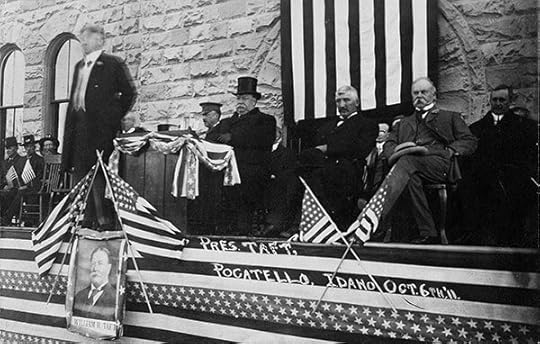 This photo was taken pre-pig on October 11, 1911. President William Howard Taft is seated behind the podium wearing a top hat. Former Governor James H. Brady is standing and speaking in an animated enough way to be little more than a blur. Seated with a bowler hat on his knee was former U.S. Senator Fred T. Dubois, owner of the gifted pig. Photo courtesy of the Idaho Transportation Department digital collection.
This photo was taken pre-pig on October 11, 1911. President William Howard Taft is seated behind the podium wearing a top hat. Former Governor James H. Brady is standing and speaking in an animated enough way to be little more than a blur. Seated with a bowler hat on his knee was former U.S. Senator Fred T. Dubois, owner of the gifted pig. Photo courtesy of the Idaho Transportation Department digital collection.
Dignitaries such as the president of the United States are often given some commemorative trinket by which they are supposed to remember their visit to Anytown, USA. Taft probably did remember the gift he got in Pocatello on October 11.
Edna Maxfield Whited Dubois, boasting an excess of names, was nevertheless referred to as “Mrs. Fred T. Dubois” when the Blackfoot Republican wrote about her gift to the president. Mrs. Dubois knew Taft from spending time in Washington, DC, where Fred served as a senator from Idaho from 1901 to 1907. She had apparently made Taft a promise that he would “taste the products of the Mountain View farm” when he visited. Senator and Mrs. Dubois owned the farm, which was near Moreland which, if you don’t know, is near Blackfoot.
The gift Mrs. Dubois gave to the president was a registered Poland China suckling pig. Now, lest you wonder what a president does with a baby pig while on a sweeping train tour of the Western states, I refer you to her original promise. He ate it. The roasted pig was the main course for the luncheon as the presidential party made its way west that day to Boise. The paper reported that the meal was “thoroughly appreciated.”
 This photo was taken pre-pig on October 11, 1911. President William Howard Taft is seated behind the podium wearing a top hat. Former Governor James H. Brady is standing and speaking in an animated enough way to be little more than a blur. Seated with a bowler hat on his knee was former U.S. Senator Fred T. Dubois, owner of the gifted pig. Photo courtesy of the Idaho Transportation Department digital collection.
This photo was taken pre-pig on October 11, 1911. President William Howard Taft is seated behind the podium wearing a top hat. Former Governor James H. Brady is standing and speaking in an animated enough way to be little more than a blur. Seated with a bowler hat on his knee was former U.S. Senator Fred T. Dubois, owner of the gifted pig. Photo courtesy of the Idaho Transportation Department digital collection.
Published on December 20, 2021 04:00
December 19, 2021
Getting Personal (Tap to Read)
If there’s a subject more likely to start a fight than the alleged Chinese tunnels in Boise, it’s probably the question of who invented finger steaks. Since my blog is well-known for providing the definitive answer to such questions I can state, without reservations, that I don’t know.
Further, this post isn’t about finger steaks at all, really, though I will say that the Wikipedia page for finger steaks (of course there is one) credits Milo Bybee as the first to say he invented finger steaks. He worked for the Torch Cafe in Boise starting in 1946. He claimed he invented them while working as a butcher for the Forest Service in McCall and brought the recipe to the Torch. Others claim it was Willie Schrier, the owner of the Torch from 1953 to 1958, who invented finger steaks. Either way the Torch seems to have been where they got famous.
In fact, the first mention of finger steaks in Boise was an ad for the Torch in the Idaho Statesman in August of 1956. And that brings us to the point of this blog. Finger steaks, recall, are just the side dish in this one.
I wanted to call your attention to a series of Personal Services ads in the Statesman that started in May of 1957 and ended in October 1958. The ads seemed to be the brainchild of Willie Schrier. The first one to appear in the Personals read:
“ADVICE TO THE LOVELORN. . .Dear Dr. Willie: ‘I love a chorus girl…buy her jewels and ermine…she still says no.” Puzzled. Dear Puzzled: ‘Chorus girls don’t want diamonds and ermine any more…They just want one of my delectable Finger Steaks.’ Dr. Willie…The Torch Café…1828 Main.”
Another personal read, “Dear Dr. Willie: ‘My boy friend has small biceps. What should he do? Agnes.’ Dear Agnes: ‘Wash his head with kerosene. That’ll kill them. Then bring him to the Torch Café, 1826 Main, and a diet of Finger Steaks will build him up.’”
Soon, a neighboring restaurant got into the act: “DEAR WILLIE—The best way to improve your atmosphere at The Torch, 1826 Main, is to remove Willie. Signed, Vince and Ed, The Royal, 1112 Main.”
In the same Personals section, Willie ‘replied.’ “SHORTAGE—The Torch, 1826 Main, is serving so many Finger Steaks that the meat suppliers are trying to breed beef that will develop double tenderloins.”
In November 1957, this pairing appeared: “PEOPLE were up in the air over the Royal’s Smokqueed Ribs long before the Russians thought of Sputnik. Ed & Vince. The Royal, 1112 Main.”
“IT’S OBVIOUS that Ed & Vince at the ROYAL are related. Vince Aguirre is Grave… and Ed Graves wishes he could Aquirre the customers my FINGER STEAKS are winning over to the TORCH! Dr. Willie Schrier, PhD. The Torch, 18th & Main.”
This good-natured jabbing went on for a couple of years between the guys at the Royal and The Torch, until Willie Schrier started the Stagecoach Inn in Garden City. That just changed the venue.
In September 1959 came this pairing in the Personals: “ATTENTION DISC JOCKERYS: Did you know that the song called “Mack The Knife” was written about a Boise man? He is the guy in the Royal’s kitchen who slices the steaks so thin you can read a newspaper through them. At the Stagecoach Inn our steaks are so thick we have to put cushions on the chairs so the customer can see over the top of them. Signed, Willie Schrier.”
“GAMBLERS ATTENTION: It is NOT true that Willie’s Stagecoach Inn has revived slot machines in Garden City. The only gamble you take when you go there is whether or not your stomach will ever be the same again after eating one of his meals. Of course, there’s not even that gamble at The Royal. Signed, Ed and Vince.”
One more pair from December 1959: “SMART ROYAL customers aren’t buying snow tires this year. Since they can’t eat those tough Royal steaks, they’re tying them onto their regular tires. I hear they’re the best non-skid steaks sold. Signed, Willie Schrier.”
“WE HEAR FOLKS are getting leery of Willie’s holiday egg nog. Seems the eggs he used are so old one customer spotted a newly hatched chick swimming in the nog. Even worse the chick had the hiccups. Signed, Ed and Vince.”
The jibing continued until about 1971 when the Personals ads stopped. Willie’s humor continued to be on display for years on the sign out in front of the Stagecoach. He was often the butt of the joke on those.
One such posting read, “CLEAN UP GARDEN CITY—WILLIE GET OUT OF TOWN.” Unfortunately, the sign went up just about the same time Willie Nelson was about to perform at the Western Idaho Fair. Nelson’s people were not amused. They asked that the sign be taken down. It was. Then Willie Nelson showed up at the Stagecoach Inn to meet the other Willie. He was out of town at the time. Nelson left him a couple of tickets to his show. That’s when employees of the restaurant put up letters reading: “WILLIE, WHEN YOU LEAVE, TAKE WILLIE WITH YOU.”
Schrier passed the Stagecoach Inn on to his daughters when he retired. It was in the family for 50 years. Today it operates under new ownership. Willie Schrier passed away in 1996.

Further, this post isn’t about finger steaks at all, really, though I will say that the Wikipedia page for finger steaks (of course there is one) credits Milo Bybee as the first to say he invented finger steaks. He worked for the Torch Cafe in Boise starting in 1946. He claimed he invented them while working as a butcher for the Forest Service in McCall and brought the recipe to the Torch. Others claim it was Willie Schrier, the owner of the Torch from 1953 to 1958, who invented finger steaks. Either way the Torch seems to have been where they got famous.
In fact, the first mention of finger steaks in Boise was an ad for the Torch in the Idaho Statesman in August of 1956. And that brings us to the point of this blog. Finger steaks, recall, are just the side dish in this one.
I wanted to call your attention to a series of Personal Services ads in the Statesman that started in May of 1957 and ended in October 1958. The ads seemed to be the brainchild of Willie Schrier. The first one to appear in the Personals read:
“ADVICE TO THE LOVELORN. . .Dear Dr. Willie: ‘I love a chorus girl…buy her jewels and ermine…she still says no.” Puzzled. Dear Puzzled: ‘Chorus girls don’t want diamonds and ermine any more…They just want one of my delectable Finger Steaks.’ Dr. Willie…The Torch Café…1828 Main.”
Another personal read, “Dear Dr. Willie: ‘My boy friend has small biceps. What should he do? Agnes.’ Dear Agnes: ‘Wash his head with kerosene. That’ll kill them. Then bring him to the Torch Café, 1826 Main, and a diet of Finger Steaks will build him up.’”
Soon, a neighboring restaurant got into the act: “DEAR WILLIE—The best way to improve your atmosphere at The Torch, 1826 Main, is to remove Willie. Signed, Vince and Ed, The Royal, 1112 Main.”
In the same Personals section, Willie ‘replied.’ “SHORTAGE—The Torch, 1826 Main, is serving so many Finger Steaks that the meat suppliers are trying to breed beef that will develop double tenderloins.”
In November 1957, this pairing appeared: “PEOPLE were up in the air over the Royal’s Smokqueed Ribs long before the Russians thought of Sputnik. Ed & Vince. The Royal, 1112 Main.”
“IT’S OBVIOUS that Ed & Vince at the ROYAL are related. Vince Aguirre is Grave… and Ed Graves wishes he could Aquirre the customers my FINGER STEAKS are winning over to the TORCH! Dr. Willie Schrier, PhD. The Torch, 18th & Main.”
This good-natured jabbing went on for a couple of years between the guys at the Royal and The Torch, until Willie Schrier started the Stagecoach Inn in Garden City. That just changed the venue.
In September 1959 came this pairing in the Personals: “ATTENTION DISC JOCKERYS: Did you know that the song called “Mack The Knife” was written about a Boise man? He is the guy in the Royal’s kitchen who slices the steaks so thin you can read a newspaper through them. At the Stagecoach Inn our steaks are so thick we have to put cushions on the chairs so the customer can see over the top of them. Signed, Willie Schrier.”
“GAMBLERS ATTENTION: It is NOT true that Willie’s Stagecoach Inn has revived slot machines in Garden City. The only gamble you take when you go there is whether or not your stomach will ever be the same again after eating one of his meals. Of course, there’s not even that gamble at The Royal. Signed, Ed and Vince.”
One more pair from December 1959: “SMART ROYAL customers aren’t buying snow tires this year. Since they can’t eat those tough Royal steaks, they’re tying them onto their regular tires. I hear they’re the best non-skid steaks sold. Signed, Willie Schrier.”
“WE HEAR FOLKS are getting leery of Willie’s holiday egg nog. Seems the eggs he used are so old one customer spotted a newly hatched chick swimming in the nog. Even worse the chick had the hiccups. Signed, Ed and Vince.”
The jibing continued until about 1971 when the Personals ads stopped. Willie’s humor continued to be on display for years on the sign out in front of the Stagecoach. He was often the butt of the joke on those.
One such posting read, “CLEAN UP GARDEN CITY—WILLIE GET OUT OF TOWN.” Unfortunately, the sign went up just about the same time Willie Nelson was about to perform at the Western Idaho Fair. Nelson’s people were not amused. They asked that the sign be taken down. It was. Then Willie Nelson showed up at the Stagecoach Inn to meet the other Willie. He was out of town at the time. Nelson left him a couple of tickets to his show. That’s when employees of the restaurant put up letters reading: “WILLIE, WHEN YOU LEAVE, TAKE WILLIE WITH YOU.”
Schrier passed the Stagecoach Inn on to his daughters when he retired. It was in the family for 50 years. Today it operates under new ownership. Willie Schrier passed away in 1996.

Published on December 19, 2021 04:00
December 18, 2021
The Size of Payette Lake (Tap to Read)
I got an interesting question from a reader about Payette Lake. They wanted to know what the lake would have looked like about 1900. Would it have been smaller?
The answer is that the lake level would have been pretty much the same as it is today, as long as you were visiting the lake in the spring. As the summer wore on it would have dropped considerably, especially in dry years.
In 1920 the water users of Payette Valley got together to apply for a storage water right on the lake of 50,000 acre feet of water. The previous year had been a dry one, causing a shortage of irrigation water in the lower Payette valley. It was the first time that had happened. Irrigators wanted it to be the last.
The Lardo Dam was born. The 120-foot dam was built to a height of about 8 feet. That cost about $20,000, a fair piece of change in 1920. Its function was to hold the lake at or near its ordinary high water mark most of the season so that it could be drawn down as needed.
Things went along well for the Lardo Dam until August of 1943 when it washed out, dropping the lake level two feet in a single day. It was replaced later that year and is still in operation, keeping the lake high for boaters, swimmers and, not incidentally, irrigators.
One interesting side note about the dam was the article written about it in the Caldwell Tribune, on March 5, 1920. The lede paragraph said, in part, “According to the application filed with the state commissioner or something or other of the Governor’s cabinet…”
The commissioner or something or other? I suspect the writer plugged that in, meaning to find out the name of the something or other before publishing the article. Then they forgot, giving me the chance to make fun of them a hundred years later.
 Payette Lake for Porcupine Point in Ponderosa State Park.
Payette Lake for Porcupine Point in Ponderosa State Park.
The answer is that the lake level would have been pretty much the same as it is today, as long as you were visiting the lake in the spring. As the summer wore on it would have dropped considerably, especially in dry years.
In 1920 the water users of Payette Valley got together to apply for a storage water right on the lake of 50,000 acre feet of water. The previous year had been a dry one, causing a shortage of irrigation water in the lower Payette valley. It was the first time that had happened. Irrigators wanted it to be the last.
The Lardo Dam was born. The 120-foot dam was built to a height of about 8 feet. That cost about $20,000, a fair piece of change in 1920. Its function was to hold the lake at or near its ordinary high water mark most of the season so that it could be drawn down as needed.
Things went along well for the Lardo Dam until August of 1943 when it washed out, dropping the lake level two feet in a single day. It was replaced later that year and is still in operation, keeping the lake high for boaters, swimmers and, not incidentally, irrigators.
One interesting side note about the dam was the article written about it in the Caldwell Tribune, on March 5, 1920. The lede paragraph said, in part, “According to the application filed with the state commissioner or something or other of the Governor’s cabinet…”
The commissioner or something or other? I suspect the writer plugged that in, meaning to find out the name of the something or other before publishing the article. Then they forgot, giving me the chance to make fun of them a hundred years later.
 Payette Lake for Porcupine Point in Ponderosa State Park.
Payette Lake for Porcupine Point in Ponderosa State Park.
Published on December 18, 2021 04:00
December 17, 2021
Women Vigilantees (Tap to Read)
There were many incidents of vigilantism in the old West, but as a rule few of the vigilantes were women. Here is an exception that proves the rule.
Sometime prior to 1898—the date is uncertain—a Montpelier saloon keep named John Lewis married a 15-year-old local girl, Afton Marie Murdock. Her parents were not happy with her marrying someone twice Marie’s age, but Bishop Henry J. Horne inexplicably performed the ceremony. Inexplicably, because John Lewis—remember that saloon—wasn’t even a Mormon.
The marriage and the saloon-keeping made Montpelier an uncomfortable place to live for the couple. They moved across the border to Fossil, Wyoming, a coal mining town.
Marie soon gave John Lewis a son, but the man did not seem happy about it, or anything else. Lewis was a vicious man as evidenced by the multiple bruises the town folk noticed on his two-year-old son. When some women saw Lewis kicking his wife, that put them over the edge.
Some 40 of the grabbed weapons at hand, buggy whips and razor strops, and marched to Lewis’ saloon. They drug the man into the street. He broke free, grabbed his sawed-off shotgun, and started to menace the women with it. His bartender grabbed the gun from the man. The women proceeded to break out the lights in the saloon and in the darkness destroyed it. Lewis, wisely, left town.
This little snippet of a story comes from Betty Penson Ward’s book Idaho Women in History by way of telling by Bear Lake High School teacher J. Patrick Wilde.
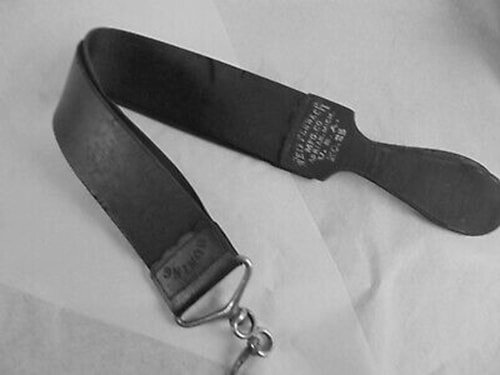 A razor strop was said to be one of the weapons used.
A razor strop was said to be one of the weapons used.
Sometime prior to 1898—the date is uncertain—a Montpelier saloon keep named John Lewis married a 15-year-old local girl, Afton Marie Murdock. Her parents were not happy with her marrying someone twice Marie’s age, but Bishop Henry J. Horne inexplicably performed the ceremony. Inexplicably, because John Lewis—remember that saloon—wasn’t even a Mormon.
The marriage and the saloon-keeping made Montpelier an uncomfortable place to live for the couple. They moved across the border to Fossil, Wyoming, a coal mining town.
Marie soon gave John Lewis a son, but the man did not seem happy about it, or anything else. Lewis was a vicious man as evidenced by the multiple bruises the town folk noticed on his two-year-old son. When some women saw Lewis kicking his wife, that put them over the edge.
Some 40 of the grabbed weapons at hand, buggy whips and razor strops, and marched to Lewis’ saloon. They drug the man into the street. He broke free, grabbed his sawed-off shotgun, and started to menace the women with it. His bartender grabbed the gun from the man. The women proceeded to break out the lights in the saloon and in the darkness destroyed it. Lewis, wisely, left town.
This little snippet of a story comes from Betty Penson Ward’s book Idaho Women in History by way of telling by Bear Lake High School teacher J. Patrick Wilde.
 A razor strop was said to be one of the weapons used.
A razor strop was said to be one of the weapons used.
Published on December 17, 2021 04:00
December 16, 2021
Nominating a Ghost (Tap to Read)
There have long been rumors of ghosts in the Idanha. Curtains are said to flap with no breeze apparent, doors open on their own, then shut when they’ve a mind to. Locks come unlocked and moans are said to emanate from the elevator shaft. The latter may be due to the age of the contraption, the oldest elevator in Idaho, or the moans could simply be coming from residents who find the lift inoperable. Again.
There have been some sensational deaths in the old hotel. In the early 1900s a man stabbed his wife to death with a pair of scissors and buried her beneath the basement floor. A bellboy was allegedly shot by a guest of the hotel in the late 1970s. The guest later committed suicide in the Idanha.
One incident that has escaped the notice of most Idanha ghost aficionados took place in 1921. That’s when a Kuna farmer by the name of Alexander Palmer Jacobs came to Boise and asked about a room at the Idanha. That was 10:30 on a Monday evening. He heard the price, then walked away. It turned out that he went to the Bristol hotel in the city, where he rented a room. Or almost. He was dissatisfied with a second-floor room and told the clerk he would be staying at the Idanha, instead.
Jacobs arrived again at the Idanha at about 11:30 and received a room on the fourth floor that was apparently to his liking.
Relatives of Mr. Jacobs called the hotel at 1 am and asked if he had rented a room there. At 3 am, Jacobs called his wife in Kuna. Then, at 5 am another call came in from Nampa. “If Mr. Jacobs leaves the hotel, or tries to leave, call 391-J-1 at Nampa immediately,” the caller pleaded.
It was about 5:15 am when two waitresses walking on the sidewalk in front of the Idanha on their way to work heard a noise as if someone were raising a shade. They looked up and saw a pair of hands gripped on the sill of an open window. Jacobs climbed onto the ledge, hesitated there for a moment, then hurled himself into the morning air. He died upon impact.
Piecing together the story police found a glass half full of a liquid to be taken before an X-ray examination and the business card of a Boise Doctor. It seems that Jacobs was due to undergo some kind of operation that day. His family had been worried about him because he had been behaving erratically for some time.
Jacobs was said to be worth some $50,000, a good sum at that time. Additionally, he owned an 80-acre ranch and properties in Boise on Grove, Broadway, and Warm Springs Avenue.
Of interest to history buffs was Jacob’s relationship to one of Boise’s earliest residents. He was the son of Cyrus Jacobs, one of the first merchants in town and the builder of the Jacobs-Uberuaga House, which is preserved today next to the Basque Museum.
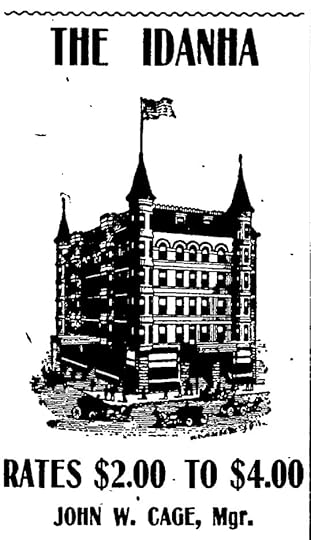
There have been some sensational deaths in the old hotel. In the early 1900s a man stabbed his wife to death with a pair of scissors and buried her beneath the basement floor. A bellboy was allegedly shot by a guest of the hotel in the late 1970s. The guest later committed suicide in the Idanha.
One incident that has escaped the notice of most Idanha ghost aficionados took place in 1921. That’s when a Kuna farmer by the name of Alexander Palmer Jacobs came to Boise and asked about a room at the Idanha. That was 10:30 on a Monday evening. He heard the price, then walked away. It turned out that he went to the Bristol hotel in the city, where he rented a room. Or almost. He was dissatisfied with a second-floor room and told the clerk he would be staying at the Idanha, instead.
Jacobs arrived again at the Idanha at about 11:30 and received a room on the fourth floor that was apparently to his liking.
Relatives of Mr. Jacobs called the hotel at 1 am and asked if he had rented a room there. At 3 am, Jacobs called his wife in Kuna. Then, at 5 am another call came in from Nampa. “If Mr. Jacobs leaves the hotel, or tries to leave, call 391-J-1 at Nampa immediately,” the caller pleaded.
It was about 5:15 am when two waitresses walking on the sidewalk in front of the Idanha on their way to work heard a noise as if someone were raising a shade. They looked up and saw a pair of hands gripped on the sill of an open window. Jacobs climbed onto the ledge, hesitated there for a moment, then hurled himself into the morning air. He died upon impact.
Piecing together the story police found a glass half full of a liquid to be taken before an X-ray examination and the business card of a Boise Doctor. It seems that Jacobs was due to undergo some kind of operation that day. His family had been worried about him because he had been behaving erratically for some time.
Jacobs was said to be worth some $50,000, a good sum at that time. Additionally, he owned an 80-acre ranch and properties in Boise on Grove, Broadway, and Warm Springs Avenue.
Of interest to history buffs was Jacob’s relationship to one of Boise’s earliest residents. He was the son of Cyrus Jacobs, one of the first merchants in town and the builder of the Jacobs-Uberuaga House, which is preserved today next to the Basque Museum.

Published on December 16, 2021 04:00
December 15, 2021
An Idaho Hero (Tap to Read)
David Bruce Bleak, born in Idaho Falls in 1932, never finished high school. After dropping out he tried his hand at farming and working for the railroad. He grew bored and decided enlisting in the U.S. Army in 1950 might provide a little excitement.
Bleak was a big man, 6 foot 5 and 250 pounds. If you saw him standing in platoon formation, you might not have readily picked him out as medic material, but the Army saw it that way. In 1952 Bleak found himself in Korea, where he was promoted to sergeant.
Sgt. Bleak was part of a patrol attached to the 2nd Battalion, 223rd Infantry. They were sent north to capture Chinese soldiers for the purpose of interrogation.
The 20-year-old soldier from Idaho and his patrol crept up a hillside where they were met with blistering enemy fire, suffering several casualties. Bleak helped the wounded, then continued to advance with his patrol.
Another man fell near the top of the hill. Three enemy troops laid down gunfire in an effort to keep the big medic from getting to the wounded soldier. That did not stop Bleak. He rushed into the trench where they were hiding and killed two enemies with his bare hands and dispatched the third with a trenching knife.
Moving out of the trench the medic saw an enemy grenade land in front of a companion. Without a thought for his own life he threw himself between the grenade and the soldier. Bleak took shrapnel to his back, but his injuries were minor.
A few minutes later a machine-gun bullet struck the young medic in the leg. Ignoring his injury, Bleak picked up a wounded man and started carrying him to safety. On his way down the hill two enemy soldiers charged with fixed bayonets. In a move that any editor would throw out if the story were fiction, Bleak grabbed the charging soldiers with his bare hands, smashing their heads together.
For his selfless heroism, David Bruce Bleak became the 61st Medal of Honor winner of the Korean War, receiving the honor from President Dwight D. Eisenhower in October, 1953.
Bleak left the Army after the war and returned to Idaho. Later he and his wife, Lois, would move to Wyoming where he would work as a meat cutter, a truck driver, and a rancher. The family-–they had four kids—moved back to Idaho where he ran a dairy farm in Moore for ten years, before taking a job as a janitor at the “site,” today called the Idaho National Laboratory. He would end his career there as chief hot cell technician, responsible for disposing of spent nuclear fuel rods.
David Bleak died in Arco in 2006 at age 74.
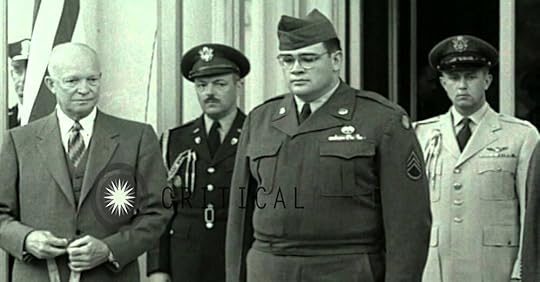 David Bruce Bleak at his Medal of Honor Ceremony.
David Bruce Bleak at his Medal of Honor Ceremony.
Bleak was a big man, 6 foot 5 and 250 pounds. If you saw him standing in platoon formation, you might not have readily picked him out as medic material, but the Army saw it that way. In 1952 Bleak found himself in Korea, where he was promoted to sergeant.
Sgt. Bleak was part of a patrol attached to the 2nd Battalion, 223rd Infantry. They were sent north to capture Chinese soldiers for the purpose of interrogation.
The 20-year-old soldier from Idaho and his patrol crept up a hillside where they were met with blistering enemy fire, suffering several casualties. Bleak helped the wounded, then continued to advance with his patrol.
Another man fell near the top of the hill. Three enemy troops laid down gunfire in an effort to keep the big medic from getting to the wounded soldier. That did not stop Bleak. He rushed into the trench where they were hiding and killed two enemies with his bare hands and dispatched the third with a trenching knife.
Moving out of the trench the medic saw an enemy grenade land in front of a companion. Without a thought for his own life he threw himself between the grenade and the soldier. Bleak took shrapnel to his back, but his injuries were minor.
A few minutes later a machine-gun bullet struck the young medic in the leg. Ignoring his injury, Bleak picked up a wounded man and started carrying him to safety. On his way down the hill two enemy soldiers charged with fixed bayonets. In a move that any editor would throw out if the story were fiction, Bleak grabbed the charging soldiers with his bare hands, smashing their heads together.
For his selfless heroism, David Bruce Bleak became the 61st Medal of Honor winner of the Korean War, receiving the honor from President Dwight D. Eisenhower in October, 1953.
Bleak left the Army after the war and returned to Idaho. Later he and his wife, Lois, would move to Wyoming where he would work as a meat cutter, a truck driver, and a rancher. The family-–they had four kids—moved back to Idaho where he ran a dairy farm in Moore for ten years, before taking a job as a janitor at the “site,” today called the Idaho National Laboratory. He would end his career there as chief hot cell technician, responsible for disposing of spent nuclear fuel rods.
David Bleak died in Arco in 2006 at age 74.
 David Bruce Bleak at his Medal of Honor Ceremony.
David Bruce Bleak at his Medal of Honor Ceremony.
Published on December 15, 2021 04:00
December 14, 2021
Boise's Broom Business (Tap to Read)
Your broom was brought to you by Benjamin Franklin. Probably. More on that in a bit.
A broom is an essential device for household cleaning. Brooms have been around for centuries, changing very little, and are still as useful as ever. When the first domestic vacuum cleaners appeared around 1905, one might have assumed the days of brooms were numbered. That portable suction device did become indispensable, yet the vacuum did not supplant the broom the way the automobile supplanted the horse and buggy.
But, let’s not get sucked into the vacuum story. This post is about brooms, specifically the brooms of Boise.
The broom business in Boise started in a small way in 1875 when Mr. Douglass Markham, a blind man, harvested a small crop of broom corn near Middleton and cobbled together a few brooms for sale. The Idaho Statesman noted that local brooms could sell for 25 cents less than imported brooms and opined that “Any man who will engage in the business extensively enough to supply the trade will soon make a nice little fortune.” The paper estimated that the fledgling territory could use 2,000 brooms a year.
By 1879 the Idaho Statesman was regularly running an ad for brooms placed by one Jacob Meyer, boasting that his brooms “have the best quality of bright, healthy broom corn, nicely turned handles, firmly bound with wire, and are strong and durable.”
Broom corn is a type of sorghum that features fibrous seed branches that can be as long as 36 inches. Table corn originated in the Americas, but broomcorn has its roots (figuratively) in central Africa. It spread all over the Mediterranean during the Dark Ages. So, one tick in the positive column for the Dark Ages, I guess.
But what about Ben? According to an 1899 article in the Idaho Statesman (and numerous other sources), Franklin “should be the patron saint of housewives.” Let me quickly add that husbands have also been known to master sweeping. The Statesman article said that there was “a very pleasant little fairy story concerning Benjamin Franklin… The story goes that Dr. Franklin was examining a whisk broom that had been brought over from England. He found a single seed on the broom, picked it off, planted it, and raised a stalk of corn from which is descended all the broom corn of the United States.”
At one time there were several hundred broom factories scattered around the country. As with most manufacturing the operations consolidated into Big Broom, so to speak. Today there has been a bit of a renaissance in broom making. It has become something of an artisanal occupation in many places.
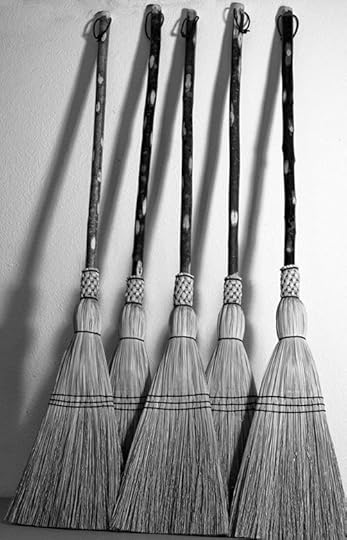
A broom is an essential device for household cleaning. Brooms have been around for centuries, changing very little, and are still as useful as ever. When the first domestic vacuum cleaners appeared around 1905, one might have assumed the days of brooms were numbered. That portable suction device did become indispensable, yet the vacuum did not supplant the broom the way the automobile supplanted the horse and buggy.
But, let’s not get sucked into the vacuum story. This post is about brooms, specifically the brooms of Boise.
The broom business in Boise started in a small way in 1875 when Mr. Douglass Markham, a blind man, harvested a small crop of broom corn near Middleton and cobbled together a few brooms for sale. The Idaho Statesman noted that local brooms could sell for 25 cents less than imported brooms and opined that “Any man who will engage in the business extensively enough to supply the trade will soon make a nice little fortune.” The paper estimated that the fledgling territory could use 2,000 brooms a year.
By 1879 the Idaho Statesman was regularly running an ad for brooms placed by one Jacob Meyer, boasting that his brooms “have the best quality of bright, healthy broom corn, nicely turned handles, firmly bound with wire, and are strong and durable.”
Broom corn is a type of sorghum that features fibrous seed branches that can be as long as 36 inches. Table corn originated in the Americas, but broomcorn has its roots (figuratively) in central Africa. It spread all over the Mediterranean during the Dark Ages. So, one tick in the positive column for the Dark Ages, I guess.
But what about Ben? According to an 1899 article in the Idaho Statesman (and numerous other sources), Franklin “should be the patron saint of housewives.” Let me quickly add that husbands have also been known to master sweeping. The Statesman article said that there was “a very pleasant little fairy story concerning Benjamin Franklin… The story goes that Dr. Franklin was examining a whisk broom that had been brought over from England. He found a single seed on the broom, picked it off, planted it, and raised a stalk of corn from which is descended all the broom corn of the United States.”
At one time there were several hundred broom factories scattered around the country. As with most manufacturing the operations consolidated into Big Broom, so to speak. Today there has been a bit of a renaissance in broom making. It has become something of an artisanal occupation in many places.

Published on December 14, 2021 04:00
December 13, 2021
Mrs. Trueblood was Accomplished, too (Tap to Read)
To many Idahoans, Ted Trueblood, born in Boise, was the Ernest Hemmingway of nonfiction. Trueblood taught generations how to hunt, fish, and enjoy the outdoors through his articles in Field and Stream magazine over the years and through his books about outdoor life. He was a founding member of the Idaho Wildlife Federation as well as an award-winning writer.
But this column isn’t about Ted Trueblood. His fame overshadowed the remarkable accomplishments of Ellen Trueblood, Ted’s wife.
Ellen, also born in Boise, was a writer in her own right. She reported for the Boise Capital New and the Nampa Free Press. Ellen was an accomplished hunter, angler, and photographer when she met Ted Trueblood, so the match seemed a natural. Following their 1939 marriage, the Truebloods honeymooned all summer long in the Idaho wilderness. That summer cemented her already strong love for the study of nature.
In the 1950s, Ellen was an amateur collector of plants. She began to focus on something that is often overshadowed by Idaho’s beautiful wildflowers. Ellen grew passionate about fungi. Although she took a few classes, she was mostly self-taught in mycology, the scientific study of fungi. As she became more proficient, she found mentors in the field to take her to the next level. After a few years of collecting, identifying, and sharing her knowledge she became the leading expert on fungi in southwestern Idaho, eastern Oregon, and northern Nevada, concentrating mostly in the Owyhees.
Fungi in the Owyhees are mostly found beneath sagebrush, though Ellen discovered them in desert ponds and creeks as well. Some are larger than a softball; some smaller than the head of a pin. If you think of mushrooms as brown, you’ve missed the colors that range from robin-egg blue through purple to vivid yellows and reds. Ellen Trueblood is credited with discovering more than 20 species of fungi.
Ellen was often seen with a slide carousel under her arm, off again to speak to a garden club about mushrooms. She had more than 2,700 slides. In 1975, when Boise State University added mycology to its curriculum, Ellen was the obvious choice to teach it.
In a 1962 article in the Idaho Free Press, Ellen Trueblood confessed a fear that many mushroom hunters have. “I spent a restless night the first time I served oyster mushrooms to my family—even though I was sure of my identification and was reassured by the book I had with me. There was that fear of toadstools that I couldn’t forget. I had to check in the night to see if my family was alive.”
After that sleepless night she educated herself and her family on how to identify a poisonous mushrooms. Her two sons, 5 and 7 at the time could quickly spot the tell-tale signs.
Some 6,500 of Ellen’s collections are housed at the University of Michigan Herbarium in Ann Arbor, College of Idaho in Caldwell, and Virginia Polytechnic Institute in Blacksburg. Ellen Trueblood passed away in 1994.
 Ted Trueblood, left, holds a fish caught by his wife Ellen. Both loved the outdoors. Ted wrote for Field and Stream for many years. Ellen was an accomplished mycologist. Photo from the Ted Trueblood Papers, Special Collections and Archives, Boise State University.
Ted Trueblood, left, holds a fish caught by his wife Ellen. Both loved the outdoors. Ted wrote for Field and Stream for many years. Ellen was an accomplished mycologist. Photo from the Ted Trueblood Papers, Special Collections and Archives, Boise State University.
But this column isn’t about Ted Trueblood. His fame overshadowed the remarkable accomplishments of Ellen Trueblood, Ted’s wife.
Ellen, also born in Boise, was a writer in her own right. She reported for the Boise Capital New and the Nampa Free Press. Ellen was an accomplished hunter, angler, and photographer when she met Ted Trueblood, so the match seemed a natural. Following their 1939 marriage, the Truebloods honeymooned all summer long in the Idaho wilderness. That summer cemented her already strong love for the study of nature.
In the 1950s, Ellen was an amateur collector of plants. She began to focus on something that is often overshadowed by Idaho’s beautiful wildflowers. Ellen grew passionate about fungi. Although she took a few classes, she was mostly self-taught in mycology, the scientific study of fungi. As she became more proficient, she found mentors in the field to take her to the next level. After a few years of collecting, identifying, and sharing her knowledge she became the leading expert on fungi in southwestern Idaho, eastern Oregon, and northern Nevada, concentrating mostly in the Owyhees.
Fungi in the Owyhees are mostly found beneath sagebrush, though Ellen discovered them in desert ponds and creeks as well. Some are larger than a softball; some smaller than the head of a pin. If you think of mushrooms as brown, you’ve missed the colors that range from robin-egg blue through purple to vivid yellows and reds. Ellen Trueblood is credited with discovering more than 20 species of fungi.
Ellen was often seen with a slide carousel under her arm, off again to speak to a garden club about mushrooms. She had more than 2,700 slides. In 1975, when Boise State University added mycology to its curriculum, Ellen was the obvious choice to teach it.
In a 1962 article in the Idaho Free Press, Ellen Trueblood confessed a fear that many mushroom hunters have. “I spent a restless night the first time I served oyster mushrooms to my family—even though I was sure of my identification and was reassured by the book I had with me. There was that fear of toadstools that I couldn’t forget. I had to check in the night to see if my family was alive.”
After that sleepless night she educated herself and her family on how to identify a poisonous mushrooms. Her two sons, 5 and 7 at the time could quickly spot the tell-tale signs.
Some 6,500 of Ellen’s collections are housed at the University of Michigan Herbarium in Ann Arbor, College of Idaho in Caldwell, and Virginia Polytechnic Institute in Blacksburg. Ellen Trueblood passed away in 1994.
 Ted Trueblood, left, holds a fish caught by his wife Ellen. Both loved the outdoors. Ted wrote for Field and Stream for many years. Ellen was an accomplished mycologist. Photo from the Ted Trueblood Papers, Special Collections and Archives, Boise State University.
Ted Trueblood, left, holds a fish caught by his wife Ellen. Both loved the outdoors. Ted wrote for Field and Stream for many years. Ellen was an accomplished mycologist. Photo from the Ted Trueblood Papers, Special Collections and Archives, Boise State University.
Published on December 13, 2021 05:12
December 12, 2021
What Were They Selling in 1890? (Tap to Read)
In case you needed a reminder that things were a little different in 1890 from today, I pulled a few advertisements from a single page from the November 14, 1890 edition of the Idaho Statesman, so you could ponder what may have been on the minds of Boise residents in that first year of statehood.
Ailments and maladies, mostly. It seems one could cure about anything by downing the right elixir. “The Celebrated French Cure,” called Aphroditine was guaranteed to “cure any form of nervous disease, or any disorder in the generative organs of either sex whether arising from the excessive use of stimulants, tobacco or opium.” Symptoms of the afflictions of those stimulants included loss of brain power, wakefulness, dizziness, and weak memory.
Whatever could not be cured by Aphroditine would surely fall to the powers of Wistar’s Balsam of Wild Cherry. It was said to clear up bronchitis, asthma, croup, influenza, whooping cough, and even consumption (tuberculosis). COVID-19 would doubtless be added to that list today.
For less deadly but still worrisome problems, one could turn to Skookum Root Hair Grower. It prevented baldness and even grew hair on bald heads if you used it religiously. The manufacturer was happy to note that the product “Contains no Mineral or Vegetable Poisons.”
Once your head was safely haired, you’d want to take care of your feet. Idaho Saddlery Company was happy to supply you with $3 shoes, if you were a man. You might even get a pair for $2 if you were a lady.
Assuming you had cured your weak mind, fixed your little hair loss problem, and shined up your shoes, you’d probably want to go courting. Successful courters would want to have the option of pulling those shades. To avoid catastrophe, you’d want none other than Hartshorn’s Self-Acting Shade Rollers. No need to accept imitations when every roller was autographed.
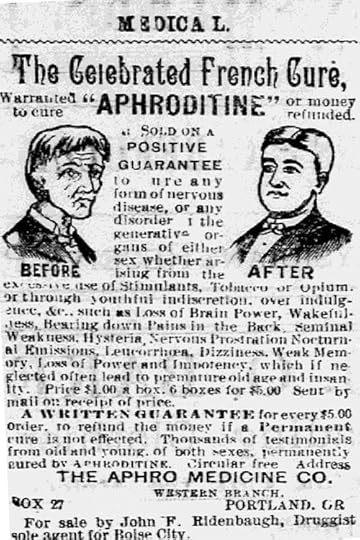
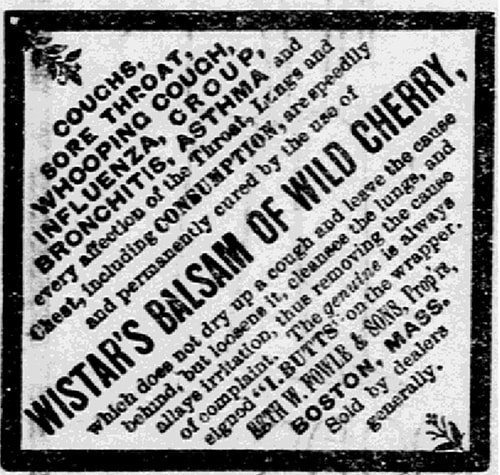



Ailments and maladies, mostly. It seems one could cure about anything by downing the right elixir. “The Celebrated French Cure,” called Aphroditine was guaranteed to “cure any form of nervous disease, or any disorder in the generative organs of either sex whether arising from the excessive use of stimulants, tobacco or opium.” Symptoms of the afflictions of those stimulants included loss of brain power, wakefulness, dizziness, and weak memory.
Whatever could not be cured by Aphroditine would surely fall to the powers of Wistar’s Balsam of Wild Cherry. It was said to clear up bronchitis, asthma, croup, influenza, whooping cough, and even consumption (tuberculosis). COVID-19 would doubtless be added to that list today.
For less deadly but still worrisome problems, one could turn to Skookum Root Hair Grower. It prevented baldness and even grew hair on bald heads if you used it religiously. The manufacturer was happy to note that the product “Contains no Mineral or Vegetable Poisons.”
Once your head was safely haired, you’d want to take care of your feet. Idaho Saddlery Company was happy to supply you with $3 shoes, if you were a man. You might even get a pair for $2 if you were a lady.
Assuming you had cured your weak mind, fixed your little hair loss problem, and shined up your shoes, you’d probably want to go courting. Successful courters would want to have the option of pulling those shades. To avoid catastrophe, you’d want none other than Hartshorn’s Self-Acting Shade Rollers. No need to accept imitations when every roller was autographed.





Published on December 12, 2021 01:56
December 10, 2021
Banned Dancing (Tap to Read)
Today I'm featuring a guest blogger, BSU Intern Sydney O'Conner. Sydney has been assisting me with research the last few months, which has been a big help to me.
Fans of the movie Footloose will undoubtedly remember the iconic scene, in which the protagonist Ren McCormack gives a speech to the town council in an effort to repeal the town’s anti-dance laws. In an attempt to disprove the traditional conception that modern dance is unholy and a catalyst for unscrupulous behavior, McCormack acknowledges all of the good that is dance.
So, what does a cheesy movie from the 80s have to do with Idaho’s history? The answer: quite a lot. The fictional town Bomont did not stand alone in its restriction of dance. Idaho too had its fair share of regulations that limited when, where, and what kind of dancing was acceptable. For example, in 1914, Pocatello passed a city ordinance that strictly barred the tango, the turkey trot, and all other peculiar dances. This law was not the only regulation placed on dancing. By Idaho law, a license secured from the county commissioners was required for the operation of public dance halls. Additionally, Idaho required dance-hall owners to adopt and post reasonable regulations for the healthful and orderly conduct of the halls. If these posted regulations were violated, the patron that made the violation could be issued a misdemeanor. Idaho additionally had prohibited dancing on Sundays.
The laws that regulated dance in Idaho however were not met without resistance. In an article published in the Idaho Republican in 1915 in part about the regulations that prohibited modern dance, it was noted that “there seems to be a mania prevailing among legislative bodies in these times for regulating every overt human act of human life by statute.”

Fans of the movie Footloose will undoubtedly remember the iconic scene, in which the protagonist Ren McCormack gives a speech to the town council in an effort to repeal the town’s anti-dance laws. In an attempt to disprove the traditional conception that modern dance is unholy and a catalyst for unscrupulous behavior, McCormack acknowledges all of the good that is dance.
So, what does a cheesy movie from the 80s have to do with Idaho’s history? The answer: quite a lot. The fictional town Bomont did not stand alone in its restriction of dance. Idaho too had its fair share of regulations that limited when, where, and what kind of dancing was acceptable. For example, in 1914, Pocatello passed a city ordinance that strictly barred the tango, the turkey trot, and all other peculiar dances. This law was not the only regulation placed on dancing. By Idaho law, a license secured from the county commissioners was required for the operation of public dance halls. Additionally, Idaho required dance-hall owners to adopt and post reasonable regulations for the healthful and orderly conduct of the halls. If these posted regulations were violated, the patron that made the violation could be issued a misdemeanor. Idaho additionally had prohibited dancing on Sundays.
The laws that regulated dance in Idaho however were not met without resistance. In an article published in the Idaho Republican in 1915 in part about the regulations that prohibited modern dance, it was noted that “there seems to be a mania prevailing among legislative bodies in these times for regulating every overt human act of human life by statute.”

Published on December 10, 2021 04:00



